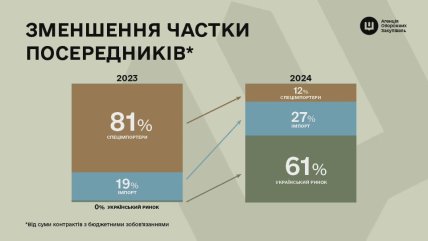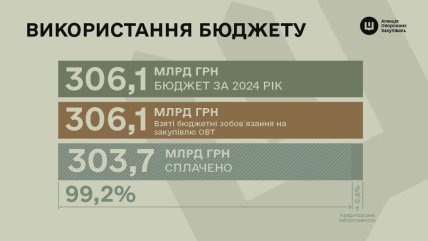More weapons, fewer intermediaries. The Defense Procurement Agency in 2024 – by the numbers - Marina Bezrukova.
On January 1, 2024, the Defense Procurement Agency became the sole organization within the Ministry of Defense responsible for purchasing weapons and military equipment for the Armed Forces of Ukraine. This marked the beginning of a reform in defense procurement, as the system required drastic changes due to its inefficiency and excessive bureaucratization.
The Agency immediately faced enormous challenges, as it needed to fundamentally change the system while swiftly addressing the urgent needs of the military and fighting for the very existence of the institution amid numerous attempts to halt or undermine its activities.
Reducing the Role of Intermediaries and Direct Contracts
In 2024, the Defense Procurement Agency succeeded in significantly lowering or at least maintaining average prices for critical ammunition, despite a persistent upward trend in prices due to a global shortage of explosives and high demand for munitions.
For instance, compared to 2023, the average price in contracts signed by the Agency in 2024 decreased for 155-mm shells by 15%; for 152-mm by 23%; and for 125-mm by 16%. This allowed for savings of billions of hryvnias, which were redirected towards the procurement of additional weapons for the Armed Forces of Ukraine.
A key factor that enabled the Defense Procurement Agency to stabilize and even reduce prices in the arms and military equipment market was the reduction of the share of intermediaries. If in the transitional contracts of the Agency signed in 2023, the share of special importers in the total contract amount was 82%, in 2024 it dropped to 12%.

The majority of the contract amounts this year are attributed to Ukrainian-produced weapons. The share of direct imports by the Agency has also significantly increased, particularly direct contracts with manufacturers.
The Agency has already signed 50 contracts with global weapons manufacturers from 13 countries. This includes direct agreements with Bulgarian producers, which, until recently, seemed impossible.
There are only a few possible models of cooperation with special importers that the Agency publicly offers. For example, when they supply weapons from countries where the Agency cannot operate directly, assuming all related risks; or when they use their own funds or work under a processing scheme.
Effectiveness of Fund Utilization
From the Agency's annual budget of 306.1 billion UAH allocated for the procurement of military equipment, 100% of budget obligations under signed contracts have been taken; 99.2% of the total amount has been paid to suppliers. This is noteworthy considering that 25% of the total budget was allocated to the Agency only in October.
The remaining 0.8% of funds is not critical and arose from technical reasons independent of the Agency (due to deliveries made on December 30 and 31 outside the payment period and because payment for certain goods can only occur after full contract fulfillment).

Recently, the Agency's ability to utilize its annual budget has sparked intense discussions. It can be assumed that information regarding significant fund balances in the Agency's accounts was used to sow doubts about its capability to use them by year-end and justify the transfer of 23 billion UAH to the State Border Guard Service of Ukraine. However, the amount of debt at the year's end would not have been greater even despite these budget withdrawals from the Agency. The need for upfront payments for contracts already signed by the Agency for the next year significantly exceeded this amount. While contracts that could have been advanced in 2024 will now be advanced in 2025, due to the funding shortage caused by this decision, the Agency must prioritize contracting extremely rigorously.
Development of Ukrainian Arms Production
The year 2024 has become a year when the Ukrainian defense industry significantly expanded its capabilities. This progress provides our country with the ability to be self-sufficient in repelling armed aggression.
Last year, the Defense Procurement Agency financed contracts with 155 Ukrainian arms manufacturers.
At the same time, a major error that occurred with the delivery of mines produced in Ukraine demonstrated the potential consequences of relying heavily on a single state manufacturer for a significant volume of a specific nomenclature. Recently, the Ministry of Defense approved an order transferring the function of technical inspection in the domestic market to the military representatives of the Ministry of Defense within the Agency. It is crucial that changes are made to the relevant regulatory framework governing our work immediately following this decision. Under such conditions, stories about confirming deliberately "inflated" production capabilities will no longer be possible.
In 2025, the Agency will diversify risks in supply by having 2-3 contracts with manufacturers and reliable suppliers for each critical nomenclature. All necessary preparations for this have already been completed.
Supply Rhythm
In 2024, the Agency supplied weapons to the Armed Forces of Ukraine worth over 180 billion UAH. Equally important is that financial resources allocated for 2024 will facilitate the delivery of weapons and military equipment worth about 46 billion UAH in the first quarter of 2025. This will ensure continuous supplies for the Armed Forces at the beginning of the new budget year.
International Cooperation
We have placed significant emphasis on establishing direct connections with procurement agencies in NATO countries. We have already signed memorandums of cooperation with agencies from five countries, namely Denmark (DALO), Estonia (ECDI), Norway (NDMA), Turkey (SSB), and Italy (ADI).
For us, this primarily presents an opportunity to exchange information on building procurement processes and the arms market. By leveraging their experience and adapting it to our wartime realities, we can quickly establish the right strategy.
One of the significant achievements of the Ministry of Defense and the Agency has been the successful implementation of the "Danish model," wherein other countries procure weapons for the Armed Forces of Ukraine directly from Ukrainian manufacturers. Denmark financed contracts with Ukrainian military equipment manufacturers totaling 535 million euros, including the production of long-range drones contracted by the Agency. All of this weaponry has already been delivered to our troops.
Cooperation with Denmark was intended to be a success story – there could be no room for error on this path. And it succeeded, as Sweden, Norway, and Lithuania also joined the model. The Agency's collaboration with partner countries is built on principles of maximum transparency. We provide them with information about manufacturers, their production capacities, and confirm the shipment of finished products.
Institutional Changes
Despite continuous contracting, last year we completely restructured the organizational framework of the Agency, creating five offices, each corresponding to a specific category of armaments: munitions; UAVs and electronic warfare; ground vehicles; air defense and aviation; special equipment.
The new organizational structure has allowed us to concentrate expertise in specific types of weaponry, synchronize work with the General Staff, and establish systematic cooperation with manufacturers, particularly considering the current conditions of the battlefield during their production. Consequently, each office has become a mediator between the military and manufacturers, taking into account the needs of the former and the capabilities of the latter.
Significant efforts have been made to maximize the efficiency of contracting. This includes monitoring prices, verifying counterparties, inspecting warehouses and production capabilities, analyzing logistics routes, and compliance control. Each contract's conclusion is preceded by immense groundwork to ensure that when a request comes from the General Staff, we are ready to finalize the contract within a few days.
Supervisory Board
A long-awaited step was the establishment of the Supervisory Board of the Agency, which began its work in December 2024. It includes independent members Ekaterina Kuznetsova, Lukash Stolyarsky, Patrick Aurou, as well as state representatives Taras Chmut and Yuriy Dzhigir. This is indeed a very professional team capable of enhancing the Agency's work and ensuring independent oversight and a new level of dialogue with international partners. The key now is the Ministry of Defense's readiness to ensure the effective operation of the supervisory board and align its powers with Ukrainian legislation and global standards of corporate governance.
Summary
For nearly the entire past year, the Defense Procurement Agency had to operate under conditions of uncertainty. This greatly impacted our team's work, which, despite everything, has already transformed the landscape of defense procurement in the country, establishing clear rules for the market and building a resilient institution free from political influence, serving the Armed Forces of Ukraine. The result is more weapons, fewer intermediaries, and increasing trust in Ukraine from international partners. By contracting weapons worth hundreds of billions of hryvnias, we have also learned to effectively navigate artificial obstacles that hinder the rapid conversion of funds into weaponry for our military. Thus, this year we will again initiate numerous changes in the regulatory and legislative framework to simplify the activities of manufacturers and significantly accelerate the supply of arms to the front.